ICT Disaster Recovery Planning
Overview
Information and communications technology (ICT) systems are critical for the operations of government agencies. Agencies depend on them to deliver public services, efficiently and effectively manage operations and fulfil statutory obligations. To make sure their systems remain available and continue to operate reliably, agencies must be able to recover and restore them in the event of a disruption.
In this audit, we examined whether the disaster recovery processes of government departments and Victoria Police are likely to be effective in the event of a disruption. We audited the Department of Economic Development, Jobs, Transport and Resources (DEDJTR), the Department of Environment, Land, Water and Planning (DELWP), the Department of Health and Human Services (DHHS) and the Department of Justice and Regulation (DJR).
Transmittal letter
Ordered to be published
VICTORIAN GOVERNMENT PRINTER November 2017
PP No 262, Session 2014–17
President
Legislative Council
Parliament House
Melbourne
Speaker
Legislative Assembly
Parliament House
Melbourne
Dear Presiding Officers
Under the provisions of section 16AB of the Audit Act 1994, I transmit my report ICT Disaster Recovery Planning.
Yours faithfully

Andrew Greaves
Auditor-General
29 November 2017
Acronyms
| AMAF | Asset Management Accountability Framework |
| ANAO | Australian National Audit Office |
| BIA | Business impact analysis |
| DEDJTR | Department of Economic Development, Jobs, Transport and Resources |
| DELWP | Department of Environment, Land, Water and Planning |
| DHHS | Department of Health and Human Services |
| DJR | Department of Justice and Regulation |
| DRP | Disaster recovery plan |
| DTF | Department of Treasury and Finance |
| ICT | Information and communications technology |
| VAGO | Victorian Auditor-General's Office |
| VGRMF | Victorian Government Risk Management Framework |
| VPDSF | Victorian Protective Data Security Framework |
| VPDSS | Victorian Protective Data Security Standards |
Audit overview
Information and communications technology (ICT) systems are critical for the operations of government agencies. Agencies depend on them to:
- deliver public services—including essential services—to the community
- efficiently and effectively manage operations
- fulfil their statutory obligations.
To make sure their systems remain available and continue to operate reliably, agencies must be able to recover and restore them in the event of a disruption—such as an event that interrupts access to premises, to the data that systems rely on, or to the systems themselves. Further, agencies need to be able to recover and restore their systems within a time frame that reflects the business-critical nature of each system.
ICT disaster recovery is the process for recovering systems following a major disruption. ICT disaster recovery planning forms part of an agency's wider business continuity strategy.
Managing disaster recovery risk presents special challenges. The likelihood of a major disaster or significant disruption is generally low, often remote—but the consequences of a system failure that cannot be restored could be significant or even catastrophic.
Without effective disaster recovery capability, agencies risk:
- extended disruption or inability to deliver public services that depend on systems
- inability to recover systems and restore lost data
- subsequent financial loss to themselves and the Victorian economy
- reputational damage, including loss of community confidence in the effective delivery of government services.
Agencies can reduce the likelihood of disruption events, however this approach can require significant investment compared to the direct costs of responding to a disruption when it occurs. It can therefore be challenging for agencies to determine the balance between focusing on preventative actions and planning to manage the consequences of possible disruptions.
In this audit, we examined disaster recovery at Victoria Police and four departments that provide essential government services—the Department of Economic Development, Jobs, Transport and Resources (DEDJTR), the Department of Environment, Land, Water and Planning (DELWP), the Department of Health and Human Services (DHHS) and the Department of Justice and Regulation (DJR).
We assessed whether their ICT disaster recovery processes are likely to be effective in the event of a disruption.
Conclusion
At present, none of the agencies we audited have sufficient assurance that they can recover and restore all of their critical systems to meet business requirements in the event of a disruption.
They do not have sufficient and necessary processes to identify, plan and recover their systems following a disruption. Compounding this is the relatively high number of obsolete ICT systems all agencies are still using to deliver some of their critical business functions. This both increases the likelihood of disruptions though hardware and software failure or external attack, and makes recovery more difficult and costly. These circumstances place critical business functions and the continued delivery of public services at an unacceptably high risk should a disruption occur.
Agencies are only just beginning to fully understand the importance of comprehensively identifying and prioritising their business functions, maintaining the ICT systems that support these functions, and establishing recovery arrangements to maintain continuity of service.
They need to significantly improve and develop well‑resourced and established processes that fully account for and can efficiently recover the critical business functions of agencies following a disruption.
Findings
Business impact analysis
None of the agencies' business impact analysis (BIA) processes are robust enough to identify and prioritise critical business functions and the recovery requirements for related ICT systems. The maturity of agencies' processes varies, and there are several common weaknesses:
- not all business functions and related ICT systems are clearly identified and prioritised
- systems' recovery requirements are only assessed in isolation, and system dependency requirements are not identified and considered
- systems' recovery requirements determined by the business have not been aligned with ICT service delivery and system recovery capabilities.
Agencies are either not performing BIA periodically, or their BIA does not have defined trigger events that prompt them to revise the analysis in response to changes at the agency—for example, a different operating environment, new services or an altered risk profile.
We measured agencies' BIA processes against the globally accepted model outlined in COBIT Process Assessment Model: Using COBIT 5, 2013 (the COBIT 5 model). This model assesses the capability of the processes using the scale shown in Figure A.
Figure A
COBIT 5 capability levels and descriptions
|
Capability level |
Description |
|
|---|---|---|
|
|
Incomplete |
Process is not in place or cannot achieve its objective |
|
|
Performed |
Process is in place and achieves its purpose |
|
|
Managed |
Process is implemented in a managed way and appropriately controlled and maintained |
|
|
Established |
Process is implemented using a defined process that is capable of achieving its outcomes |
|
|
Predictable |
Process operates consistently within defined limits to achieve its outcomes |
|
|
Optimised |
Process is continuously improved to meet relevant current and projected enterprise goals |
Source: VAGO, based on COBIT 5 ISO/IEC 15504 capability levels.
Figure B shows our assessment of the capability of the agencies' BIA processes.
Figure B
Capability of audited agencies' BIA process
|
Criterion |
DEDJTR |
DELWP |
DHHS |
DJR |
Victoria Police |
|---|---|---|---|---|---|
|
BIA process |
|
|
|
|
|
Source: VAGO.
Without a robust BIA, agencies have difficulty determining which systems need disaster recovery capability and in what order they should recover systems. The immaturity of these BIA processes means agencies risk not being able to identify all the systems that support their critical business functions. Further, they risk not having the necessary disaster recovery capability to ensure that their ICT systems can provide continuous service or be recovered rapidly following a disruption.
In this report, our assessment is based on the critical systems that agencies have identified.
Disaster recovery processes
None of the agencies' disaster recovery processes are robust enough to effectively and efficiently recover all critical systems in the event of a disruption. Agencies' disaster recovery processes show similar degrees of capability.
We used the COBIT 5 model to assess agencies' disaster recovery processes, as shown in Figure C.
Figure C
Capability of audited agencies' disaster recovery processes
|
Criterion |
DEDJTR |
DELWP |
DHHS |
DJR |
Victoria Police |
|---|---|---|---|---|---|
|
Disaster recovery processes |
|
|
|
|
|
Source: VAGO.
Across all the audited agencies, we identified that disaster recovery processes require improvement:
- Agencies do not have an established, coordinated department-wide approach to ICT disaster recovery planning—instead, management of disaster recovery is decentralised and managed by individual business divisions.
- Not all systems that support critical business functions have disaster recovery plans (84 out of 222 systems). Agencies have not performed a risk assessment to determine which critical systems need a disaster recovery plan or identified appropriate continuity processes for when systems are unavailable.
Disaster recovery testing
No agency is performing functional disaster recovery tests for all systems that support critical business functions and, when agencies do conduct testing, they are not performing it consistently.
No agencies' functional disaster recovery testing verifies whether the agency can recover systems to meet the two key recovery objectives:
- recovery time—the target time required for the recovery of an ICT system after a disruption
- recovery point—the point in time to which an agency must restore data after a disruption, for example, restoring data to the end of the previous day's processing.
The reason why agencies cannot verify whether their systems are able to meet these recovery objectives is because their BIA fails to determine them.
Figure D shows the number of disaster recovery plans agencies have developed and tested for the systems that support critical business functions. Most do not have disaster recovery plans.
Figure D
Critical systems and disaster recovery plans
Note: DRP = disaster recovery plan.
Source: VAGO.
Without having disaster recovery plans and testing them regularly, agencies risk not being able to recover systems in a timely way because of a lack of guidance for staff on what is required to bring systems back online. As a result, critical government services—such as criminal justice and policing operations—may be unavailable for longer than is necessary, depending on the scale of the disruption.
Disaster recovery training
None of the agencies provide enough training to staff with specific disaster recovery roles and responsibilities to equip them with the knowledge and skills needed to manage the recovery of a system after a disruption. Active participation in disaster recovery tests and theoretical training is a key tool for developing staff skills and experience.
Data centre arrangements
Victoria Police hosts its ICT systems in the same building as its operations. There is a risk that disruptions affecting the operational site—such as a fire—will also affect its systems. Victoria Police has other data centre facilities, which can mitigate the risk and provide systems with the required redundancy capability—the duplication of a system to increase its reliability and minimise downtime in the event of disruption.
Victoria Police is currently in the process of relocating its systems to a separate data centre facility, which it expects to complete by 2020. Victoria Police intends to enhance the disaster recovery capability of all critical systems by 31 December 2018, in preparation for the data centre relocation. However, the risk will remain until then.
Other audited agencies host most of their systems at purpose-built data centres operated by CenITex, a government body that provides centralised ICT support. In addition, third-party providers host a small number of their systems.
Redundancy of outsourced systems
Agencies need to consider effective redundancy capability to increase their systems' reliability and availability. Six of the seven government departments and their associated agencies outsource the hosting of the majority of their systems to CenITex (the Department of Education and Training hosts and maintains most of its systems in-house).
CenITex submitted a paper to the Victorian Secretaries' Board in November 2016 highlighting the recoverability limitations if one of its data centres was unavailable. Only 36 per cent of the 25 most important systems identified by agencies that are hosted by CenITex have secondary stand by systems to provide a full and rapid recovery of systems, as shown in Figure E.
Figure E
Critical systems hosted at CenITex
Source: VAGO, based on data from CenITex.
Thirteen of the remaining systems have no redundancy capability—including systems that provide services for criminal justice, marine safety and bushfire management.
Agencies intend to reassess these 25 most important systems, review their order of priority, and identify the estimated investment required to establish and maintain an appropriate level of redundancy. No date has been set for this activity to occur.
Obsolescence in systems
In the audited agencies, 41 per cent of the systems that support critical business functions are obsolete. Figure F shows the number of obsolete systems supporting critical business functions such as financial management, child protection and management of criminal justice, based on information provided by the audited agencies.
Figure F
Obsolete critical systems in the audited agencies
Source: VAGO.
At 79 per cent, Victoria Police has the highest percentage of systems that are obsolete, and DELWP has the lowest at 26 per cent.
The high rate of system obsolescence across all agencies is because:
- agencies do not maintain detailed registers of their systems with enough version information to enable effective monitoring
- agencies only consider and review obsolescence when a system is approaching or is already at the end of its life
- maintaining software and hardware compatibility across a variety of technology platforms is complex and difficult—software components are often heavily customised, which inhibits the upgrade process due to potentially high upgrade costs
- life cycle planning of systems is inadequate and often not performed regularly enough to ensure that systems are refreshed on a regular basis.
All agencies have identified obsolescence in systems as one of the key risks in their enterprise risk register. To manage the risk, agencies are implementing programs to upgrade and replace obsolete systems, although these are not occurring frequently enough and often only when systems are approaching their end of life.
When government agencies run systems that are close to or beyond their end of life, they increase the risk of these systems not being fit for purpose and, consequently, the risk of poor or degraded service delivery. Systems that operate on obsolete hardware or software present a significant disaster recovery risk, because of the limited availability of hardware spare parts, vendor technical support, and staff knowledge and skill. At worst, agencies risk catastrophic equipment failure, extended outage of public services, and exploitation of vulnerable systems by computer virus attacks.
Recommendations
We recommend that the Department of Economic Development, Jobs, Transport and Resources, the Department of Environment, Land, Water and Planning, the Department of Health and Human Services, the Department of Justice and Regulation and Victoria Police:
- appoint a team of suitably qualified and experienced professionals to form a collaborative disaster recovery working group to:
- provide advice and technical support
- share lessons learnt based on disaster recovery tests and exercises
- coordinate disaster recovery requirements for resources shared between agencies
- identify, develop, implement and manage initiatives that may impact multiple agencies
- coordinate funding requests to ensure critical investments and requirements are prioritised
- perform a gap analysis on their disaster recovery requirements and resource capabilities to determine the extent of the capability investment that will be required
- develop disaster recovery plans for the systems that support critical business functions and test these plans according to the disaster recovery test program
- provide advice and training to staff on:
- newly developed frameworks, policies, standards and procedures to increase awareness and adoption as needed
- specific disaster recovery systems
- establish system obsolescence management processes to:
- identify and manage systems at risk of becoming obsolete, those that will soon have insufficient support or those that will be difficult to manage when they become obsolete
- enable strategic planning, life-cycle optimisation and the development of long-term business cases for system life-cycle support
- provide executive with information to allow risk-based investment decisions to be made.
We recommend that the Department of Economic Development, Jobs, Transport and Resources, the Department of Health and Human Services, the Department of Justice and Regulation and Victoria Police:
- set up disaster recovery frameworks to provide guidelines and minimum standards for ICT disaster recovery planning, including:
- developing a strategy to establish the minimum levels of readiness and appropriate governance oversight
- establishing the requirements, frequency and format of disaster recovery tests based on systems' criticality
- establishing policies, standards and procedures for a consistent approach.
We recommend that the Department of Environment, Land, Water and Planning:
- update its business impact analysis to identify:
- system dependencies for critical business functions
- requirements for the system recovery time objective and recovery point objective
- determine a recovery strategy for systems that support critical business functions.
We recommend that the Department of Health and Human Services:
- update its Business Continuity Policy to require business units to consult with system owners and the Business Technology and Information Management group as part of the business impact analysis process, to validate the maximum allowable outage and recovery time objectives
- update the business impact analysis process to identify system dependencies for critical business functions
- determine a recovery strategy for systems that support critical business functions.
We recommend that the Department of Justice and Regulation:
- update its Crisis and Continuity Policy to require business units to consult with system owners and the Knowledge, Information and Technology Services group as part of the business impact analysis process, to validate the maximum allowable outage and recovery time objectives
- develop a framework to assist business units to determine the criticality of business functions and identify disaster recovery requirements
- determine a recovery strategy for systems that support critical business functions
- update the business impact analysis process to include components that:
- evaluate and rank the criticality of business functions
- analyse impacts caused by disruption to critical business functions.
Responses to recommendations
We have consulted with DEDJTR, DELWP, DHHS, DJR and Victoria Police, and we considered their views when reaching our audit conclusions. As required by section 16(3) of the Audit Act 1994, we gave a draft copy of this report to those agencies and asked for their submissions and comments. We also provided a copy of the report to the Department of Premier and Cabinet.
The following is a summary of those responses. The full responses are included in Appendix A.
All of the audited agencies accepted the recommendations. DEDJTR, DHHS, DJR and Victoria Police provided detailed action plans on how they have begun to address our recommendations and the time frames for these activities. DELWP noted the findings in the report. It outlined its work to assess its ICT assets and systems under its ICT Criticality Framework and will work closely with the other audited agencies to enhance its disaster recovery planning capabilities.
1 Audit context
The Victorian Government delivers a diverse range of services that are important to the economic and social wellbeing of Victorians—from management of state finances to child protection and criminal justice.
The capacity to deliver these services depends in part on the availability and reliability of ICT systems. Being unable to access these systems for an extended period—particularly those used to deliver essential services—could have significant consequences for individuals and for the state, including major cost implications. Disruptions to non-essential services can also result in inconvenience and inefficiencies.
Government agencies face situations within and outside their control that may disrupt their services. These range from equipment failure, fire and theft through to malicious activity and natural disasters.
To respond effectively to major disruptions, including loss of systems, agencies need to design and implement systems and procedures that will support the continuation and resumption of their services.
1.1 ICT disaster recovery
Business continuity management covers the overall process of managing a disruption and re-establishing critical business functions. A key part of any agency's response to a disruption is providing the necessary resources for the agency to continue delivering critical business functions.
ICT disaster recovery is one element of business continuity management—it is the mechanism that agencies use to recover their systems following a major disruption.
Business impact analysis
A BIA is the basis for planning an effective disaster recovery program. It identifies business functions that are critical to the daily operations of an agency. The BIA identifies how much time business functions have to return to full or acceptable degraded level of operation following a disruption.
The Australian and New Zealand standard for managing disruptions—AS/NZS 5050:2010 Business continuity – Managing disruption-related risk—states that agencies should perform a BIA as part of an effective risk management program.
An agency's BIA should define its recovery time objective and recovery point objective for restoring systems—see Figure 1A for definitions. The agency's disaster recovery plans should enable it to meet these objectives.
The results of the BIA help the agency to prioritise business functions and allocate resources, as well as informing its investment in recovery strategies.
Key terms
Figure 1A defines the key terms we use in this report.
Figure 1A
Key definitions in ICT disaster recovery
|
Term |
Definition |
|---|---|
|
Business continuity management |
The discipline of managing essential business operations and ensuring they continue following a disruption, possibly at a degraded rate or at a level acceptable to key stakeholders. |
|
Business continuity planning |
The process of developing a practical plan for how the business can prepare for and continue to operate after a disruption. |
|
Business impact analysis |
A management-level analysis that evaluates the risks of disruption to critical business functions, including consideration of the impacts of capability loss over time, and resource needs and their interdependencies. |
|
Critical business function |
A function that an agency needs to effectively achieve its objectives. |
|
Data centre |
A facility used to house systems and associated components, such as telecommunications, backup power supplies and environmental controls such as air conditioning, fire suppression and security devices. |
|
Disruption |
An event that threatens business survival or significantly disrupts normal business operations beyond the business's usual capability for managing operational faults. |
|
Maximum allowable outage |
The maximum period of time that an agency can tolerate the disruption of a critical business function, before the achievement of its objectives is adversely affected. |
|
Obsolescence |
A state in which systems have become out of date because they are no longer supported by the vendor. |
|
Recovery time objective |
The target time required for the recovery of an ICT system after a disruption. |
|
Recovery point objective |
The point in time to which an agency must restore data after a disruption—for example, restoring data to the end of the previous day's processing. |
|
Redundancy |
The addition of a secondary system to the primary system, to enable continuous system operation in the event that the primary system fails. |
Source: VAGO, based on ANAO, Business Continuity Management, 2014.
Disaster recovery framework
The Victorian Government Risk Management Framework (VGRMF) sets out the minimum risk management requirements that an agency must meet to demonstrate that it is managing risk effectively, including risks to other agencies and significant risks for the state.
The VGRMF adopts the Australian and New Zealand standard for risk management—AS/NZS ISO 31000:2009 Risk management – Principles and guidelines—which provides a generic, internationally accepted standard for best practice risk management.
The standard encourages agencies to establish an effective framework for managing risk, setting the agency's policy, demonstrating commitment, providing resources, assigning responsibilities and monitoring progress.
An effective framework for disaster recovery consists of an overarching disaster recovery policy and relevant standards and guidelines covering:
- governance and strategy for disaster recovery
- disaster recovery processes and controls
- creation, testing and maintenance of disaster recovery plans
- awareness and training on disaster recovery.
Disaster recovery plans
According to AS/NZS 5050:2010, having a disaster recovery plan improves an agency's ability to respond quickly and effectively to a disruption. As agencies become more reliant on ICT systems to run their operations, the importance of disaster recovery planning for the recovery of these systems increases.
Disaster recovery testing
Disaster recovery testing helps agencies verify their ability to recover ICT systems after a disruption. A disaster recovery test involves recovering and restoring a system by following the procedures defined in a disaster recovery plan. AS/NZS 5050:2010 states that agencies should conduct periodic disaster recovery tests to ensure that disaster recovery plans will work effectively.
Disaster recovery training
The international standard ISO/IEC 27031:2011 Guidelines for information and communication technology readiness for business continuity states: 'A co‑ordinated program should be implemented to ensure that processes are in place to regularly promote disaster recovery awareness in general, as well as assess and enhance competency of all relevant personnel key to the successful implementation of disaster recovery.'
Training is an important component of an effective disaster recovery framework—it helps staff gain knowledge and skills to manage the recovery of a system following a disruption. Active participation in disaster recovery tests and theoretical training are key methods for developing staff skills and competencies.
Outsourcing disaster recovery services
Government agencies can outsource the hosting and disaster recovery of ICT systems to third-party service providers, although outsourcing does not absolve agencies of all responsibilities for disaster recovery. There must still be careful planning and integration between the agency and the service provider.
CenITex is an ICT shared services agency set up by the Victorian Government in 2008 to centralise ICT support for government departments and agencies. CenITex delivers ICT infrastructure, application hosting and desktop services.
CenITex provides ICT services to six of the seven Victorian Government departments and their associated agencies (rather than use CenITex's services, the Department of Education and Training hosts and maintains most of its systems in-house). CenITex also provides agencies with optional disaster recovery services. CenITex and agencies establish memorandums of understanding to define their roles, responsibilities and requirements.
Contracts with third-party service providers and memorandums of understanding with CenITex set out terms of service and parties' responsibilities. By establishing responsibilities and requirements, third-party service providers and government agencies can monitor and report on how they are managing service delivery, including disaster recovery.
Recovery of systems and services hosted by CenITex
In 2016, CenITex developed a framework that provides a recovery order for systems that it hosts, in the event of a data centre loss. This framework was developed in consultation with all seven Victorian portfolio departments and the Department of Premier and Cabinet's Emergency Management and Enterprise Solutions branches. The departments have agreed to a combined recovery order for 25 of their most important systems.
In November 2016, CenITex submitted a paper to the Victorian Secretaries' Board outlining the key recoverability limitations for these systems if one of CenITex's data centres became unavailable:
- Core systems—such as network, email, desktop, security and support services—would take significant time to restore and would only be restored to a reduced capacity.
- Some of the 25 most important systems do not have redundancy capability. A secondary stand-by system would enable full and rapid recovery of the system.
CenITex plans to improve its business services, reduce the impact of system outages and improve the recoverability of these systems. The departments plan to review the priority order of their 25 most important systems and estimate the investment required to establish and maintain their recoverability.
1.2 ICT asset management
A better practice approach to ICT asset management involves acquiring, using and disposing of ICT assets to maximise service delivery over an asset's useful life. Life cycle management mitigates risk and helps define and plan the cost of updating and replacing assets when they become obsolete.
Asset management policy and guidance
The Department of Treasury and Finance (DTF) provides guidance to Victorian Government agencies to help them develop and implement good asset management practices. DTF administers a range of financial management policies and frameworks, including the Victorian Government Asset Management Accountability Framework (AMAF), published in February 2016. The AMAF establishes a set of mandatory requirements and general guidance for government agencies to manage their assets, including ICT assets.
Figure 1B shows the key elements of the AMAF that government agencies should consider in managing assets throughout their life cycle.
Due to the shorter life cycle of ICT assets, some elements of the model may need to be concurrent, with planning for the next generation of ICT assets often needing to begin as soon as a new ICT asset is implemented.
Figure 1B
The AMAF asset life cycle
Source: DTF.
Managing obsolescence in systems
Under the Financial Management Act 1994, agencies and their accountable officers are responsible for identifying and managing their assets, including ICT assets. This includes developing and implementing risk-management strategies.
To manage risk, an agency must identify, assess and prioritise existing and potential risks, enabling it to mitigate and manage potential impacts by implementing new policies and procedures.
There are a number of risks associated with ageing and obsolescence that are common to all assets. These risks are particularly acute for ICT assets due to the high speed of innovation in ICT. Unlike other assets with relatively long life spans, ICT assets can quickly become obsolete if not managed carefully.
Inadequate management of obsolescence in ICT systems can lead to poor or degraded service delivery by government agencies. At worst, it could lead to catastrophic equipment failure, extended outage of a public service, or exploitation of vulnerable systems by computer virus attacks.
1.3 Legislation and standards
Standing Directions of the Minister for Finance 2016
The Standing Directions of the Minister for Finance 2016, which supplement the Financial Management Act 1994, require agencies to develop, implement and maintain documented business continuity planning processes consistent with the latest Australian, New Zealand, international or industry-recognised standard.
Victorian Protective Data Security Framework and Standards
The Victorian Protective Data Security Framework (VPDSF) and the Victorian Protective Data Security Standards (VPDSS) establish mandatory requirements to protect public sector data and provide for governance across the four domains of information, personnel, ICT and physical security. Under the VPDSS, agencies must have effective business continuity processes in place to enable them to respond to and recover from any event that affects the confidentiality, integrity and availability of public sector data.
Government departments and Victoria Police must comply with the VPDSF and VPDSS requirements by July 2018. Previously, Victoria Police had to comply with the Standards for Law Enforcement Data Security, but it now operates under the VPDSS.
Practice standards
The following standards include relevant principles for better practice disaster recovery processes and controls:
- ISO 22301:2012 Societal security – Business continuity management systems – Requirements
- AS/NZS 5050:2010 Business continuity – Managing disruption-related risk
- ISO/IEC 27031:2011 Information technology – Security techniques – Guidelines for information and communication technology readiness for business continuity.
Other better practice standards relevant to maintaining effective disaster recovery processes and controls include:
- Business continuity management: Building resilience in public sector entities (better practice guide), Australian National Audit Office, June 2009
- Contingency Planning Guide for Federal Information Systems (NIST Special Publication 800-34 Rev. 1), National Institute of Standards and Technology (United States), May 2010.
The following standards include relevant principles for process assessment as a basis for use in determining process capability:
- ISO/IEC 15504-2:2003 Information technology – Process assessment
- COBIT Process Assessment Model: Using COBIT 5, 2013—see Appendix B for descriptions of the capability ratings.
1.4 Why this audit is important
The use of ICT systems has fundamentally changed how agencies operate. Agencies depend on systems to:
- deliver public services—including essential services—to the Victorian community
- efficiently and effectively manage government operations
- fulfil their statutory obligations.
Agencies need to have effective processes to recover systems in the event of a disruption. As ICT systems become increasingly critical for government operations and the wider Victorian community, the need to ensure systems can continue to operate and be recovered rapidly in the event of a disruption is growing.
1.5 Previous audits
Our audits have consistently found weaknesses in both business continuity planning and ICT disaster recovery planning.
Our November 2013 report Portfolio Departments and Associated Entities: Results of the 2012–13 Audits included results of our assessment of departments' business continuity and disaster recovery processes. We identified limited awareness and management of disaster recovery capabilities and processes which resulted in risks for departments' and agencies' ability to recover operations and provide essential public services in the event of a disruption.
Our October 2014 report Information and Communications Technology Controls Report 2013–14 reported similar weaknesses in agencies' ICT disaster recovery processes and controls. We identified these findings again in our October 2015 report Financial Systems Controls Report: Information Technology 2014−15.
1.6 What this audit examined and how
Our objective was to determine whether selected departments and Victoria Police can effectively recover their critical ICT systems and data in the event of a disruption.
We assessed whether these agencies had plans and processes in place for:
- identifying critical information assets and infrastructure, and prioritising their recovery through a BIA
- recovering critical information assets and infrastructure that support critical business functions as identified by the BIA
- periodically testing critical information assets and infrastructure that support critical business functions to validate their disaster recovery capability
- using data centres to host systems and provide redundancy capabilities
- ensuring contracts for outsourced disaster recovery services are robust
- conducting a maintenance program to identify, manage and upgrade obsolete systems
- ensuring continuous improvement in monitoring, evaluating and reporting on agencies' level of preparedness for disaster recovery.
Taking a risk-based approach, we focused on Victoria Police and four departments that rely heavily on systems to provide critical government services. The audited agencies are DEDJTR, DELWP, DHHS, DJR and Victoria Police.
We conducted this audit in accordance with section 15 of the Audit Act 1994 and Australian Auditing and Assurance Standards. The total cost of this audit was $455 000.
In accordance with section 20(3) of the Audit Act 1994, we express no adverse comment or opinion about anyone we name in this report.
1.7 Report structure
The remainder of this report is structured as follows:
- Part 2 discusses the results of our assessment for DEDJTR
- Part 3 discusses the results of our assessment for DELWP
- Part 4 discusses the results of our assessment for DHHS
- Part 5 discusses the results of our assessment for DJR
- Part 6 discusses the results of our assessment for Victoria Police.
2 Department of Economic Development, Jobs, Transport and Resources
In this part of the report, we assess whether DEDJTR can effectively recover its critical ICT systems and data if a disruption occurs.
DEDJTR's disaster recovery processes are not robust enough to effectively and efficiently recover all critical systems after a disruption. DEDJTR currently only has capability to recover selected critical systems. The department needs to further develop its disaster recovery processes and capabilities to minimise any loss of critical services in the event of a disruption.
2.1 Business impact analysis
DEDJTR's Technology Services division is responsible for implementing disaster recovery requirements for ICT systems that it supports. Business groups own and manage the systems and are responsible for managing their recovery if a disruption occurs.
Figure 2A summarises our assessment of DEDJTR's BIA process and its components against COBIT 5 ISO/IEC 15504-based capability levels and a maturity rating system based on the ISO/IEC 15504-2:2003 standard—see Appendix B for descriptions of the capability ratings.
Figure 2A
Assessment of DEDJTR's BIA process and components
| BIA process—overall capability |
|
|
Component |
Capability rating |
|---|---|
|
List all of the critical business processes that underpin achievement of the agency's objectives |
Partially achieved |
|
Rank the processes in order of importance to the agency's objectives and exclude those processes not considered critical to achieving the objectives |
Partially achieved |
|
Consider process interdependencies that exist |
Partially achieved |
|
Determine the minimum requirements necessary to perform each critical process |
Partially achieved |
|
Obtain executive endorsement of prioritised list of critical business processes |
Partially achieved |
|
Evaluate the impacts of a loss of each critical process according to the agency's objectives |
Partially achieved |
|
Identify interim processing procedures (alternative or manual processing) or techniques to be adopted during the recovery phase |
Partially achieved |
|
Determine the maximum allowable outage for each critical process |
Partially achieved |
|
Determine internal and external critical interdependencies |
Partially achieved |
|
Identify vital records |
Partially achieved |
|
Determine the recovery time objective for each critical business process and ICT system |
Partially achieved |
|
Determine the recovery point objective for data |
Partially achieved |
|
Obtain executive endorsement of the BIA |
Partially achieved |
Source: VAGO.
DEDJTR's former arrangements for significant business disruptions were an aggregation of business continuity plans and processes prepared for predecessor departments. These varied in approach and format. DEDJTR has developed a new business continuity management policy and framework, which it is currently implementing and expects to complete by 30 November 2017. The new business continuity management policy and framework includes the implementation of a department-wide BIA that will identify the processes, systems and resources required to recover its essential business functions.
Once completed, the business continuity management framework and BIA should:
- ensure that the Technology Services and Emergency Management divisions are consulted on the identification of systems and dependencies
- ensure that business areas consult with Technology Services to identify realistic recovery time and recovery point objectives for their systems
- provide information to Technology Services about systems, maximum acceptable outages and recovery time objectives identified in business continuity plans.
DEDJTR's intended approach is reasonable and aligns with better practice standards. As DEDJTR is currently implementing this process, it was only able to provide limited evidence to demonstrate that it will achieve the above.
Until DEDJTR implements its new policy and framework, it will continue to use 2014 business continuity requirements for systems identified as needing disaster recovery capability.
Once DEDJTR has implemented the BIA, it plans to conduct the analysis every two years unless significant changes in the department's structure or strategic direction trigger an earlier review.
2.2 Disaster recovery
Figure 2B summarises our assessment of DEDJTR's disaster recovery framework and its components against COBIT 5 ISO/IEC 15504-based capability levels and ISO/IEC 15504–2:2003 respectively.
Figure 2B
Assessment of DEDJTR's disaster recovery process and components
|
Disaster recovery process—overall capability |
|
|
Component |
Capability rating |
|---|---|
|
Maintain an ICT disaster recovery continuity framework |
Partially achieved |
|
Review, maintain and improve the ICT disaster recovery plans |
Partially achieved |
|
Conduct ICT disaster recovery plan testing |
Achieved |
|
Conduct ICT disaster recovery training |
Not achieved |
Source: VAGO.
The implementation of disaster recovery capabilities for ICT systems depends on business requirements identified through the BIA. The BIA resulting from DEDJTR's business continuity management refresh program—expected to be completed by 30 November 2017—should verify whether there are additional systems that need disaster recovery capability.
DEDJTR is reviewing the current process. In its current form, the process does not effectively ensure a standardised department-wide approach for planning, implementing and managing disaster recovery requirements to support DEDJTR's essential business functions.
The Technology Services division is now developing the necessary governance arrangements, frameworks and policies to better manage a comprehensive and prioritised approach to disaster recovery and expects to complete this process by 31 January 2018. Once completed, it should:
- coordinate the development and maintenance of disaster recovery plans with the relevant service providers
- coordinate the testing of critical systems with relevant service providers.
DEDJTR's intended approach aligns with better practice standards.
Disaster recovery plans and testing
Since the formation of the department in 2015, DEDJTR has not identified all of the systems that support its critical business functions or determined a recovery strategy for each system, including whether the system requires disaster recovery capability.
Disaster recovery plans exist for nine of DEDJTR's 13 systems that support critical business functions. Seven of these nine systems have a tested disaster recovery plan, as shown in Figure 2C.
Figure 2C
DEDJTR's critical systems and disaster recovery plans
Note: DRP = disaster recovery plan.
Source: VAGO, based on information from DEDJTR.
Individual business groups and Technology Services perform functional disaster recovery tests on seven of these systems annually. Since 1 January 2015, DEDJTR has commissioned an annual independent service assurance review of the ICT control environment for three of these systems—which includes a component of disaster recovery.
Functional disaster recovery tests verify DEDJTR's ability to recover systems based on business recovery requirements previously identified by the former Department of State Development, Business and Innovation and the former Department of Transport, Planning and Local Infrastructure. DEDJTR has not validated these business recovery requirements.
Disaster recovery training
DEDJTR performs functional disaster recovery tests on its critical systems but does not provide theoretical awareness training to staff with specific disaster recovery roles and responsibilities.
Once DEDJTR's Technology Services division has developed the disaster recovery governance arrangements, frameworks and policies, it intends to:
- inform relevant departmental business groups so they can plan, implement and manage disaster recovery of their systems
- provide training for staff on their roles and responsibilities in a disaster recovery event, to prepare them for participation in exercises, tests and actual emergency situations
- conduct a post-test review to evaluate the disaster recovery response process, to identify and correct any weaknesses, to determine strengths and to promote continuous improvements in the disaster recovery process.
Outsourced disaster recovery arrangement with CenITex
DEDJTR engages CenITex for specific disaster recovery services, including annual disaster recovery testing and hosting disaster recovery capability of selected systems at the CenITex data centre. CenITex and DEDJTR manage the terms and conditions of these specific disaster recovery services through statement‑of‑work documents.
Figure 2D shows the extent of redundancy capability in DEDJTR's and the other audited agencies' critical systems hosted by CenITex.
Figure 2D
Redundancy capability in DEDJTR's and other agencies' critical systems hosted by CenITex
Note: Nineteen of the 25 critical systems hosted by CenITex belong to the in-scope audited agencies.
Source: VAGO, based on data from CenITex.
Not all of DEDJTR's critical systems hosted by CenITex have redundancy capabilities. DEDJTR's business continuity management framework review should produce a new department-wide BIA and verify whether:
- the four systems hosted by CenITex that do not currently have redundancy capabilities need such capability
- the business requirements to have redundancy capabilities—partial or full—for the two systems hosted by CenITex are still valid.
2.3 Obsolescence in systems
DEDJTR's business groups are responsible for managing their own systems' life cycles. They can consult with Technology Services for advice on managing system obsolescence.
DEDJTR also relies on CenITex for managing infrastructure equipment and has supplemented its infrastructure expenditure with specific funding initiatives when required.
Figure 2E shows the number of systems supporting critical business functions at DEDJTR that it reports as being obsolete.
Figure 2E
Obsolete critical systems at DEDJTR
Source: VAGO.
DEDJTR identifies and tracks system obsolescence for corporate systems through its enterprise risk management process. DEDJTR upgrades or replaces these systems based on business case submissions.
DEDJTR's business groups are responsible for their own business systems, and must identify their requirements, obtain funding and liaise with Technology Services to assist with mobilising replacement projects.
This process is not effective for centrally identifying and managing the risk of system obsolescence. DEDJTR's business groups need to take greater responsibility for actively managing obsolescence in their systems. They need to use the business continuity management process as it matures to obtain system life cycle information to help them better identify and manage system obsolescence.
3 Department of Environment, Land, Water and Planning
In this part of the report, we assess whether DELWP can effectively recover its critical ICT systems and data if a disruption occurs.
DELWP's disaster recovery processes are not robust enough to effectively and efficiently recover all critical systems after a disruption. DELWP currently only has capability to recover selected critical systems. The department needs to further develop its disaster recovery processes and capabilities to minimise any loss of critical services in the event of a disruption.
3.1 Business impact analysis
Divisions within DELWP manage their own disaster recovery requirements and capabilities, and manage business continuity with support from the Business Governance Services branch. DELWP has developed a business continuity and resilience management framework to set business continuity guidelines and a disaster recovery framework to set disaster recovery planning guidelines for the divisions.
DELWP's Business Governance Services branch coordinates with the department's divisions to perform, review and update their BIAs annually as part of business continuity. Each BIA identifies the division's critical business functions, resource requirements and any supporting system that may require disaster recovery capability.
DELWP formalised its business continuity policies and procedure documents in 2015.
Figure 3A summarises our assessment of DELWP's BIA process and its components against COBIT 5 ISO/IEC 15504-based capability levels and a rating system based on the ISO/IEC 15504-2:2003 standard—see Appendix B for descriptions of the capability ratings.
Figure 3A
Assessment of DELWP's BIA process and components
|
BIA process—overall capability |
|
|
Component |
Capability rating |
|---|---|
|
List all of the critical business processes that underpin achievement of the agency's objectives |
Largely achieved |
|
Rank the processes in order of importance to the entity's objectives and exclude those processes not considered critical to achieving the objectives |
Partially achieved |
|
Consider process interdependencies that exist |
Largely achieved |
|
Determine the minimum requirements necessary to perform each critical process |
Largely achieved |
|
Obtain executive endorsement of prioritised list of critical business processes |
Largely achieved |
|
Evaluate the impacts of a loss of each critical process according to the agency's objectives |
Largely achieved |
|
Identify interim processing procedures (alternative or manual processing) or techniques to be adopted during the recovery phase |
Largely achieved |
|
Determine the maximum allowable outage for each critical process |
Largely achieved |
|
Determine internal and external critical interdependencies |
Partially achieved |
|
Identify vital records |
Partially achieved |
|
Determine the recovery time objective for each critical business process and ICT system |
Not achieved |
|
Determine the recovery point objective for data |
Partially achieved |
|
Obtain executive endorsement of the BIA |
Largely achieved |
Source: VAGO.
DELWP's BIA process identifies time-critical business functions and their various dependencies, including systems, human resources, third-party service providers, utilities and infrastructure. The BIA process focuses on identifying contingencies for the recovery of critical business functions within the functions' maximum allowable outage time.
DELWP divisions are not consistently identifying systems' dependencies or the recovery time objective and recovery point objective as part of the BIA process. These information gaps may affect how DELWP determines a critical business function's maximum allowable outage time, as DELWP may need to recover specific systems first to enable the effective recovery of critical business functions.
DELWP advised that it plans to collect and assess this information in future annual review cycles as the process matures.
3.2 Disaster recovery
In July 2015, DELWP's internal audit reported weaknesses in its disaster recovery processes. The report found that:
- DELWP did not have a coordinated department-wide approach to disaster recovery planning
- disaster recovery policies and procedure documents had been drafted but not yet formalised
- identification and criticality assessment of systems had not been recently performed and there was no clear alignment of ICT disaster recovery plans with business requirements.
Figure 3B summarises our assessment of DELWP's disaster recovery process and its components against COBIT 5 ISO/IEC 15504-based capability levels and ISO/IEC 15504-2:2003 respectively.
Figure 3B
Assessment of DELWP's disaster recovery process and components
|
Disaster recovery process—overall capability |
|
|
Component |
Capability rating |
|---|---|
|
Maintain an ICT disaster recovery continuity framework |
Partially achieved |
|
Review, maintain and improve the ICT disaster recovery plans |
Partially achieved |
|
Conduct ICT disaster recovery plan testing |
Partially achieved |
|
Conduct ICT disaster recovery training |
Not achieved |
Source: VAGO.
At the time of the July 2015 internal audit, DELWP developed a new ICT operating model to introduce clear accountability, responsibility and consistency for managing and delivering ICT services. Since the audit, DELWP has developed policies, procedures and guidance documents to coordinate and support ICT disaster recovery planning.
DELWP's business divisions are accountable for funding, resourcing and making decisions about the ICT services that support business processes. DELWP is gradually adopting the policies and procedures that it has developed as part its ICT disaster recovery planning process.
DELWP also developed a criticality framework—a set of policies, procedures and tools to identify and support management of critical ICT systems under the new ICT operating model. The criticality framework states that DELWP divisions will be responsible for assessing their systems to determine if they are critical. The divisions responsible for managing critical systems will be required to complete annual assessments of the systems—including managing disaster recovery.
DELWP reported that it expects the maturity of disaster recovery processes to improve over time as it implements the ICT operating model and criticality framework, enabling it to monitor the overall condition of its ICT systems.
DELWP will need to maintain a coordinated department-wide approach to disaster recovery by ensuring that divisions receive guidance on their approach and adhere to the new criticality framework.
Disaster recovery plans and testing
DELWP has disaster recovery plans for 37 out of 80 systems that divisions manage independently. There is no consistent department-wide approach for functional disaster recovery tests, because individual divisions determine the type and timing of tests they perform. The divisions do not have a testing schedule that determines the priority, frequency and scope of testing disaster recovery plans.
Functional recovery tests performed by DELWP verify whether it can recover the system, but not whether this can occur in line with business recovery requirements—because DELWP has not determined them.
Figure 3C shows the number of systems supporting critical business functions at DELWP that have a disaster recovery plan.
Figure 3C
DELWP's critical systems and disaster recovery plans
Note: DRP = disaster recovery plan.
Source: VAGO, based on information from DELWP.
DELWP has not tested the recoverability of the remaining 43 systems supporting critical business functions. There are no disaster recovery plans for these systems, and it is unclear whether these systems require disaster recovery capability.
DELWP advised that it expects the oversight and management of testing critical systems with disaster recovery capability to improve over time as it implements the new ICT operating model and criticality framework. Until the oversight of these systems improves, DELWP leaves itself at risk of being unable to support critical business functions during a disruption and extended outage of systems.
Disaster recovery training
DELWP performs functional disaster recovery tests on its critical systems but does not provide theoretical awareness training to staff with specific disaster recovery roles and responsibilities.
Outsourced disaster recovery arrangement with CenITex
DELWP engages CenITex for specific disaster recovery services, including annual disaster recovery testing and hosting disaster recovery capability of selected systems at the CenITex data centre. CenITex and DELWP manage the terms and conditions of these specific disaster recovery services through statement-of-work documents.
Figure 3D shows the extent of redundancy capability in DELWP's and the other audited agencies' critical systems hosted by CenITex.
Figure 3D
Redundancy capability in DELWP's and other agencies' critical systems hosted by CenITex
Note: Nineteen of the 25 critical systems hosted by CenITex belong to the in-scope audited agencies.
Source: VAGO, based on data from CenITex.
DELWP has not performed a criticality assessment of systems to determine whether:
- the three systems hosted by CenITex that do not currently have redundancy capabilities require such capability
- the business requirements to have redundancy capabilities for one system hosted by CenITex are still valid.
In the absence of this assessment, DELWP is unable to determine if its resourcing and funding for the four critical systems hosted at CenITex is appropriate and whether the highest-priority systems have adequate recovery capability in the event of a disaster.
DELWP also needs to determine whether any of its other systems that support critical business functions should require redundancy capabilities.
3.3 Obsolescence in systems
DELWP has begun to identify and assess the health and life cycle stages of its systems. DELWP has developed a system upgrade roadmap consisting of approved and proposed projects up until December 2018. It is identifying initiatives that will deliver new and enhanced ICT services to support its key business functions.
Figure 3E shows the number of systems supporting critical business functions at DELWP that it reports as being obsolete.
Figure 3E
Obsolete critical systems at DELWP
Source: VAGO, based on information from DELWP.
To further manage system obsolescence, divisions will be required to complete an annual system life cycle verification under DELWP's criticality framework, which is in the early stages of implementation. The framework will require divisions to manage the life cycle of systems that support critical business functions, including identifying and managing systems that are obsolete or approaching end of life.
DELWP's ICT Governance Committee has approved the refresh of the department's ICT strategy, beginning in the second quarter of 2017–18, which will provide direction and guidance to divisions about investing in and managing their ICT services.
4 Department of Health and Human Services
In this part of the report, we assess whether DHHS can effectively recover its critical ICT systems and data if a disruption occurs.
DHHS's disaster recovery processes are not robust enough to effectively and efficiently recover all critical systems after a disruption. DHHS currently only has capability to recover selected critical systems. The department needs to further develop its disaster recovery processes and capabilities to minimise any loss of critical services in the event of a disruption.
4.1 Business impact analysis
DHHS is a large department and has about 1 300 users of its systems across 11 divisions. Within DHHS, business units and the Emergency Management branch jointly develop BIAs based on DHHS's business continuity management policy and framework.
Figure 4A summarises our assessment of DHHS's BIA process and its components against COBIT 5 ISO/IEC 15504-based capability levels and a rating system based on the ISO/IEC 15504-2:2003 standard—see Appendix B for descriptions of the capability ratings.
Figure 4A
Assessment of DHHS's BIA process and components
|
BIA process—overall capability |
|
|
Component |
Capability rating |
|---|---|
|
List all of the critical business processes that underpin achievement of the agency's objectives |
Largely achieved |
|
Rank the processes in order of importance to the entity's objectives and exclude those processes not considered critical to achieving the objectives |
Partially achieved |
|
Consider process interdependencies that exist |
Partially achieved |
|
Determine the minimum requirements necessary to perform each critical process |
Largely achieved |
|
Obtain executive endorsement of prioritised list of critical business processes |
Largely achieved |
|
Evaluate the impacts of a loss of each critical process according to the agency's objectives |
Largely achieved |
|
Identify interim processing procedures (alternative or manual processing) or techniques to be adopted during the recovery phase |
Largely achieved |
|
Determine the maximum allowable outage for each critical process |
Partially achieved |
|
Determine internal and external critical interdependencies |
Partially achieved |
|
Identify vital records |
Partially achieved |
|
Determine the recovery time objective for each critical business process and ICT system |
Not achieved |
|
Determine the recovery point objective for data |
Not achieved |
|
Obtain executive endorsement of the BIA |
Partially achieved |
Source: VAGO.
The business continuity management framework requires DHHS to perform a BIA twice per year or more often when there is a major departmental change. The BIA identifies DHHS's time-critical business functions, resource requirements and dependencies for its ICT systems, equipment and human resources. The BIA also outlines contingency strategies for the recovery of business functions following a disruption.
DHHS's BIA process:
- identifies business functions' maximum allowable outage times, but business units do not always consult with the Business Technology and Information Management branch to validate whether the systems they rely on for business functions can be recovered within the maximum allowable outage time
- does not consistently identify resource dependencies required to recover business functions such as dependencies on systems outside the department
- does not consistently identify the recovery time objective and recovery point objective of systems that support business functions.
Inconsistent identification and evaluation of disaster recovery requirements and system recovery capabilities between business units and Business Technology and Information Management branch will affect DHHS's ability to recover critical business functions in the time required by business units.
4.2 Disaster recovery
In the past, DHHS has relied on business units to determine disaster recovery requirements for their systems, to inform risk-based investment decisions. As a result, DHHS has no central oversight of this process and has been unable to effectively manage disaster recovery for systems that support critical business functions.
In 2016, the Business Technology and Information Management branch began to identify and assess disaster recovery requirements for 20 systems that support business functions. The branch advised that it will perform a gap analysis of the 20 systems' disaster recovery capability and requirements. The branch has commenced this activity and expects to complete it by 30 June 2018.
DHHS established the Disaster Recovery and Business Continuity Planning Reference Group in July 2017 to improve decision-making processes for disaster recovery investment. The group aims to:
- develop an evaluation process to objectively assess risks and compare disaster recovery requirements for competing divisions and systems
- use the newly developed evaluation process to make better risk-based decisions and investments
- provide independent advice to DHHS on the implementation of its disaster recovery strategy.
The reference group will also:
- oversee DHHS's ICT disaster recovery strategy to provide consistent guidance
- ensure policies and standards are in place to support DHHS's recovery objectives and ensure compliance
- work to reduce the confusion in DHHS about the distinct but related topics of business continuity and disaster recovery
- advise on ways of determining requirements, expectations and planning for business continuity and disaster recovery.
Figure 4B summarises our assessment of DHHS's disaster recovery process and its components against COBIT 5 ISO/IEC 15504-based capability levels and ISO/IEC 15504–2:2003 respectively.
Figure 4B
Assessment of DHHS's disaster recovery process and components
|
Disaster recovery process—overall capability |
|
|
Component |
Capability rating |
|---|---|
|
Maintain an ICT disaster recovery continuity framework |
Partially achieved |
|
Review, maintain and improve the ICT disaster recovery plans |
Partially achieved |
|
Conduct ICT disaster recovery plan testing |
Partially achieved |
|
Conduct ICT disaster recovery training |
Not achieved |
Source: VAGO.
DHHS's disaster recovery processes are limited, and there is no strategy or framework to manage ICT disaster recovery. The Disaster Recovery and Business Continuity Planning Reference Group has been set up to address these issues. Its objective is to align the two planning processes to ensure a well‑managed and coordinated approach to disaster recovery requirements. DHHS has approved additional funding to develop and implement a disaster recovery strategy.
Disaster recovery plans and testing
DHHS does not have disaster recovery plans for all of its systems that support critical business functions. Disaster recovery plans currently exist for 11 systems managed by the Business Technology and Information Management branch and previously identified as requiring disaster recovery capability.
The branch performs annual functional disaster recovery tests on these systems. Functional recovery tests verify that DHHS can recover the system, but these tests do not verify whether this can occur in line with business recovery requirements—because DHHS has not determined them.
DHHS has invested in enhancing the disaster recovery capabilities of a number of its critical systems in recent years. DHHS expects other systems' disaster recovery capabilities will also mature as it implements planned investments in disaster recovery. DHHS plans to allocate the available funds for disaster recovery activities based on risk identification and prioritisation.
Figure 4C shows the number of systems supporting DHHS's critical business functions that have a disaster recovery plan.
Figure 4C
DHHS's critical systems and disaster recovery plans
Note: DRP = disaster recovery plan.
Source: VAGO, based on information from DHHS.
Disaster recovery training
DHHS performs functional disaster recovery tests on its critical systems, but it does not provide theoretical awareness training for staff who have specific roles and responsibilities for disaster recovery.
Outsourced disaster recovery arrangement with CenITex
DHHS engages CenITex for specific disaster recovery services, including annual disaster recovery testing and hosting disaster recovery capability of selected systems at the CenITex data centre. CenITex and DHHS manage the terms and conditions of these specific disaster recovery services through statement‑of‑work documents.
Figure 4D shows the extent of redundancy capability in DHHS's and the other audited agencies' critical systems hosted by CenITex.
Figure 4D
Redundancy capability in DHHS's and other agencies' critical systems hosted by CenITex
Note: Nineteen of the 25 critical systems hosted by CenITex belong to the in-scope audited agencies.
Source: VAGO, based on data from CenITex.
DHHS is currently replacing the one system that does not have disaster recovery capability. DHHS advised that the new version of this system will incorporate redundancy capability, and it plans to implement it by 30 June 2018.
Disaster recovery compliance
We reviewed DHHS's processes for managing disaster recovery compliance. DHHS does not have a compliance framework, and its processes are not robust enough for it to effectively monitor, measure, evaluate and report compliance on disaster recovery processes. DHHS performs compliance activities for specific systems only.
DHHS has not actively performed audits on its disaster recovery program and processes in the past five years. DHHS needs to conduct regular audits on these elements, as well as annual functional disaster recovery tests.
4.3 Obsolescence in systems
Figure 4E shows the number of systems supporting critical business functions at DHHS that it reports as being obsolete.
Figure 4E
Obsolete critical systems at DHHS
Source: VAGO, based on information from DHHS.
DHHS's executive board evaluates and endorses the annual ICT investment program. Following a period of under-investment, DHHS has begun to fund investments in infrastructure and systems in the past four years.
DHHS has substantial work ahead of it, to develop a mature life cycle management approach for maintaining its critical systems and gaining assurance that those systems remain reliable and are recoverable after a disaster.
DHHS has identified obsolete systems and allocated funds to upgrade these systems—including two of its most critical systems. DHHS is consolidating and documenting information on obsolete systems in its Meta ICT Information Asset and Applications Register to better inform future asset identification and decision-making on system upgrades.
5 Department of Justice and Regulation
In this part of the report, we assess whether DJR can effectively recover its critical ICT systems and data if a disruption occurs.
DJR's disaster recovery processes are not robust enough to effectively and efficiently recover all critical systems after a disruption. DJR currently only has capability to recover selected critical systems. The department needs to do additional work to further develop its disaster recovery processes and capabilities to minimise any loss of critical services in the event of a disruption.
5.1 Business impact analysis
DJR's Crisis and Continuity Policy requires business units to review and update their business continuity plans annually, including BIAs.
Figure 5A summarises our assessment of DJR's BIA process and its components against COBIT 5 ISO/IEC 15504-based capability levels and a rating system based on the ISO/IEC 15504-2:2003 standard—see Appendix B for descriptions of the capability ratings.
Figure 5A
Assessment of DJR's BIA process and components
|
BIA process—overall capability |
|
|
Component |
Capability rating |
|---|---|
|
List all of the critical business processes that underpin achievement of the agency's objectives |
Largely achieved |
|
Rank the processes in order of importance to the agency's objectives and exclude those processes not considered critical to achieving the objectives |
Partially achieved |
|
Consider process interdependencies that exist. |
Partially achieved |
|
Determine the minimum requirements necessary to perform each critical process |
Largely achieved |
|
Obtain executive endorsement of prioritised list of critical business processes |
Largely achieved |
|
Evaluate the impacts of a loss of each critical process according to the agency's objectives |
Partially achieved |
|
Identify interim processing procedures (alternative or manual processing) or techniques to be adopted during the recovery phase |
Largely achieved |
|
Determine the maximum allowable outage for each critical process |
Largely achieved |
|
Determine internal and external critical interdependencies |
Partially achieved |
|
Identify vital records |
Partially achieved |
|
Determine the recovery time objective for each critical business process and ICT system |
Partially achieved |
|
Determine the recovery point objective for data |
Partially achieved |
|
Obtain executive endorsement of the BIA |
Largely achieved |
Source: VAGO.
At DJR, 50 business units have a BIA, and five new business units are each developing one. DJR's BIA process does not:
- evaluate and rank the criticality of business processes relative to one another
- assess the impact of the loss of a critical business process
- identify and consider system dependency requirements when determining the maximum allowable outage time for business functions and recovery times for systems.
DJR needs to address these deficiencies in its BIA process to enable it to develop a more robust process.
When performing the annual BIA, business units do not always seek advice from DJR's Knowledge, Information and Technology Services group about aligning the maximum allowable outage and recovery time objective with their systems and service delivery capabilities.
DJR has used its BIA process to identify critical system dependencies for all but one of its critical systems. It is currently working to address this gap—however, it does not have a criticality framework or guidance to support business units in performing these activities.
DJR is currently revising the BIA process to include an overarching BIA. This will help DJR to align its approaches to business continuity and disaster recovery, and create central oversight of business units' assessments, enabling DJR to develop a department-wide approach.
5.2 Disaster recovery
DJR does not have a strategy, framework or policies for managing disaster recovery of its systems.
Within DJR, individual business units are responsible for ensuring appropriate disaster recovery arrangements for their systems. The Knowledge, Information and Technology Services group is responsible for disaster recovery arrangements for agency-wide systems. This group provides disaster recovery advice and support to business units if requested—although, to date, few business units have taken up this support. DJR has produced new guidance that recommends business units consult with the Knowledge, Information and Technology Services group.
Figure 5B summarises our assessment of DJR's disaster recovery process and its components against COBIT 5 ISO/IEC 15504-based capability levels and ISO/IEC 15504–2:2003 respectively.
Figure 5B
Assessment of DJR's disaster recovery process and components
|
Disaster recovery process—overall capability |
|
|
Component maturity |
Capability rating |
|---|---|
|
Maintain an ICT disaster recovery continuity framework |
Not achieved |
|
Review, maintain and improve the ICT disaster recovery plans |
Partially achieved |
|
Conduct ICT disaster recovery plan testing |
Partially achieved |
|
Conduct ICT disaster recovery training |
Not achieved |
Source: VAGO.
Disaster recovery plans and testing
DJR does not have full understanding of its systems' disaster recovery requirements. It conducted a review in July 2016 which found that, of its 60 critical systems, 13 have disaster recovery plans but 47 do not. The Knowledge, Information and Technology Services group is currently working with business units to validate existing disaster recovery requirements and develop new disaster recovery plans where needed.
Functional recovery tests performed by DJR verify whether it can recover the system, but not whether this can occur in line with business recovery requirements—because DJR has not determined them.
Figure 5C shows the number of systems supporting critical business functions at DJR that have a disaster recovery plan.
Figure 5C
DJR's critical systems and disaster recovery plans
Note: DRP = disaster recovery plan.
Source: VAGO, based on information from DJR.
Disaster recovery training
DJR performs functional disaster recovery tests on its critical systems but does not provide theoretical awareness training to staff with specific roles and responsibilities for disaster recovery.
Outsourced disaster recovery arrangement with CenITex
DJR engages CenITex for specific disaster recovery services, including annual disaster recovery testing and hosting disaster recovery capability of selected systems at the CenITex data centre. CenITex and DJR manage the terms and conditions of these specific disaster recovery services through statement‑of‑work documents.
Figure 5D shows the extent of redundancy capability in DJR's and the other audited agencies' critical systems hosted by CenITex.
Figure 5D
Redundancy capability in DJR's and other agencies' critical systems hosted by CenITex
Note: Nineteen of the 25 critical systems hosted by CenITex belong to the in-scope audited agencies.
Source: VAGO, based on data from CenITex.
Only one of DJR's four critical systems hosted by CenITex has redundancy capability. DJR does not have full visibility of the extent of its systems, and which ones have or need disaster recovery arrangements.
DJR is currently revising the BIA process to include an overarching BIA. This will help DJR align its approaches to business continuity and disaster recovery, and create central oversight of business unit assessments, enabling DJR to develop a department-wide approach. This will verify whether:
- the two systems hosted by CenITex that do not currently have redundancy capabilities need such capability
- the business requirements to have redundancy capabilities—partial or full—for the other two systems hosted at CenITex are still valid.
5.3 Obsolescence in systems
Figure 5E shows the number of obsolete systems supporting critical business functions as reported by DJR.
Figure 5E
Obsolete critical systems at DJR
Source: VAGO, based on information provided by DJR.
DJR's 2016 enterprise architecture review highlighted that, across all of the department's systems, only 55 were appropriate for future investment. The remaining 310 systems needed to be re-examined, upgraded, consolidated or decommissioned.
Due to DJR's model of individual business units being responsible for the life cycle management and asset register of their own systems, DJR does not have full visibility of the risks associated with the use of obsolete systems.
DJR's Knowledge, Information and Technology Services group is managing 22 specific projects and planning further projects to replace and upgrade selected systems and infrastructure, scheduled for completion by 2020. These projects are a reasonable way of reducing risk of obsolescence.
6 Victoria Police
In this part of the report, we assess whether Victoria Police can effectively recover its critical ICT systems and data if a disruption occurs.
Victoria Police's disaster recovery processes are not robust enough to effectively and efficiently recover all critical systems after a disruption. The agency currently only has capability to recover selected critical systems. Victoria Police needs to do additional work to further develop its disaster recovery processes and capabilities to minimise any loss of critical services in the event of a disruption.
6.1 Business impact analysis
In October 2016, an internal audit reported weaknesses in Victoria Police's ICT disaster recovery processes. The report found that Victoria Police:
- has not formally assessed critical business processes or functions to enable it to identify disaster recovery requirements to support business continuity
- does not have a disaster recovery framework, strategies, plans or processes
- does not have a defined and established test program and execution strategy.
Victoria Police has developed and started implementing a comprehensive plan to respond to the weaknesses identified in the audit, including:
- forming a governance committee and appropriate working groups
- performing a BIA to identify and review critical systems and ensure alignment between business requirements, recovery capabilities and disaster recovery strategy
- developing a disaster recovery framework, strategy and program.
It expects to complete this work by 31 December 2017.
Figure 6A summarises our assessment of Victoria Police's BIA process and its components against COBIT 5 ISO/IEC 15504-based capability levels and a rating system based on the ISO/IEC 15504-2:2003 standard—see Appendix B for descriptions of the capability ratings.
Figure 6A
Assessment of Victoria Police's BIA process and components
|
BIA process—overall capability |
|
|
Component |
Capability rating |
|---|---|
|
List all critical business processes that underpin achievement of agency's objectives |
Partially achieved |
|
Rank the processes in order of importance to the agency's objectives and exclude those processes not considered critical to achieving the objectives |
Partially achieved |
|
Consider process interdependencies that exist |
Partially achieved |
|
Determine the minimum requirements necessary to perform each critical process |
Partially achieved |
|
Obtain executive endorsement of prioritised list of critical business processes |
Partially achieved |
|
Evaluate the impacts of a loss of each critical process according to the agency's objectives |
Partially achieved |
|
Identify interim processing procedures (alternative or manual processing) or techniques to be adopted during the recovery phase |
Partially achieved |
|
Determine the maximum allowable outage for each critical process |
Partially achieved |
|
Determine internal and external critical interdependencies |
Partially achieved |
|
Identify vital records |
Partially achieved |
|
Determine the recovery time objective for each critical business process and ICT system |
Partially achieved |
|
Determine the recovery point objective and data |
Partially achieved |
|
Obtain executive endorsement of the BIA |
Not achieved |
Source: VAGO.
Victoria Police is currently performing a BIA to:
- identify critical business functions, systems and resource dependencies
- determine maximum allowable outage for critical business functions
- determine recovery time and recovery point objectives for systems that support critical business functions
- analyse the operational and financial impacts of disruption to critical business functions
- assess risks and determine which critical systems need disaster recovery capabilities and, for systems that don't require disaster recovery capability, appropriate recovery strategies.
By August 2017, Victoria Police had performed a BIA for 30 of 78 business functions, with work continuing to address the remaining functions. The BIA will identify and gather key information that should help Victoria Police to:
- align system recoverability capabilities to business continuity requirements
- develop contingency plans to prepare for the loss of a business function
- identify opportunities for improvement and future technology upgrades, based on gap analysis of system and ICT service capabilities.
Victoria Police is taking appropriate steps to address its weaknesses. Completed BIAs have identified and gathered key information to help manage ICT disaster recovery planning.
System dependencies
Victoria Police, like many agencies, usually assesses a system's requirements in isolation and fails to consider each system's dependency on other systems when defining the recovery time objective and recovery point objective.
Figure 6B describes a case study about system dependencies for Victoria Police's custody management process.
Figure 6B
Case study: System dependencies for Victoria Police and DJR
|
Victoria Police uses the Attendance and Custody system for custody management, as part of operational policing. This system relies on information from DJR's e*Justice system, which DJR uses to manage evidence briefs and information about people accused of crimes. The existing BIA processes of both agencies are inadequate for identifying dependent systems. The e*Justice system also has no disaster recovery capability. Both agencies have begun to addresses these weaknesses, including:
Currently, the recovery time and recovery point objectives of both systems do not align. This will increase the time required to recover the Attendance and Custody system if a disruption occurs, and will result in services being unavailable for longer than necessary. |
Source: VAGO, based on information from Victoria Police and DJR.
6.2 Disaster recovery
Victoria Police has sought to address weaknesses in its disaster recovery processes by appointing an ICT Disaster Recovery Manager to help with internal initiatives and projects such as developing a disaster recovery framework and policies, and performing a gap analysis of disaster recovery requirements and the capabilities of resources and systems. Victoria Police has drafted a disaster recovery framework and policies, which are awaiting management endorsement.
Figure 6C summarises our assessment of Victoria Police's disaster recovery process and its components against COBIT 5 ISO/IEC 15504-based capability levels and ISO/IEC 15504–2:2003 respectively.
Figure 6C
Assessment of Victoria Police's disaster recovery process and components
|
Disaster recovery process—overall capability |
|
|
Component |
Capability rating |
|---|---|
|
Maintain an ICT disaster recovery continuity framework, policy and strategy |
Partially achieved |
|
Review, maintain and improve the ICT disaster recovery plans |
Partially achieved |
|
Conduct ICT disaster recovery plan testing |
Partially achieved |
|
Conduct ICT disaster recovery training |
Not achieved |
Source: VAGO.
Victoria Police's disaster recovery processes require further improvement—they only support three key operational systems, and there is a lack of governance and strategic approach to disaster recovery across the agency.
Victoria Police recognises the need to further improve its management of disaster recovery as it upgrades existing systems to replace obsolete infrastructure.
Victoria Police expects that its current work to address weaknesses will determine future disaster recovery investment and activities, and help to identify additional systems that need disaster recovery capability. Victoria Police intends to report and monitor progress of this work monthly in internal governance forums.
Disaster recovery plans and testing
Victoria Police has not yet identified all of its critical systems and determined whether they need disaster recovery capability.
Disaster recovery plans exist for only three of Victoria Police's 24 systems that support critical business functions. Victoria Police has tested all three of these plans, as shown in Figure 6D.
Figure 6D
Victoria Police's critical systems and disaster recovery plans
Note: DRP = disaster recovery plan.
Source: VAGO, based on information from Victoria Police.
Of the three Victoria Police systems that have disaster recovery plans:
- one system is supported by annual functional disaster recovery tests
- the other two systems are subject to discretionary functional disaster recovery tests, but these do not occur annually.
Victoria Police has formally set out disaster recovery arrangements in a contract with its main third-party ICT service provider to support and perform functional disaster recovery tests for these systems.
Functional recovery tests only verify that Victoria Police can recover a system, but they do not verify whether it can recover the system in line with business recovery requirements—because Victoria Police has not determined these requirements.
Victoria Police has not tested whether it can recover the remaining 21 critical systems, and no disaster recovery plans exist for these systems. Victoria Police advised that completion of the BIA review will identify whether any additional systems need disaster recovery capabilities and will inform decision-making on future disaster recovery investment and activities.
Disaster recovery training
Victoria Police does not provide theoretical disaster recovery awareness training for staff with specific roles and responsibilities for disaster recovery.
Data centre arrangement
Victoria Police hosts its systems at its operational site. It has other secondary data centre facilities, which can mitigate the risk and provide redundancy capabilities for these systems.
There is a risk that disruptions affecting the operational site—such as a fire—will also affect the systems hosted in the same building. Victoria Police is currently in the process of relocating its systems to a separate data centre facility, which it expects to complete by 2020.
Victoria Police intends to enhance the disaster recovery capability of all critical systems by 31 December 2018 in preparation for the data centre relocation. However, the risk will remain until the move is finished.
6.3 Obsolescence in systems
One of the objectives in Victoria Police's 2016–17 Business Technology Strategy is to review existing systems to verify their operational sustainability.
Figure 6E shows the number of systems supporting critical business functions in Victoria Police that it identifies as obsolete.
Figure 6E
Obsolete critical systems in Victoria Police
Source: VAGO, based on information from Victoria Police.
In 2016, Victoria Police upgraded the ICT infrastructure at its data centre to create a new technology platform for hosting and supporting future system upgrades and investment.
Victoria Police advised it will consider the investment priorities identified in its Business Technology Strategy review for replacing outdated and unsupported systems that are currently still in use.
Victoria Police is currently upgrading seven critical systems and one further system it classifies as vital, as part of its Infrastructure Lifecycle Program. It plans to replace these systems between 2020 and 2025, using its new technology platform.
Victoria Police has not effectively managed the risk of system obsolescence, as shown by the high percentage of its critical systems that are obsolete. Victoria Police needs to manage system obsolescence more effectively, using its Business Technology Strategy and Infrastructure Lifecycle Program to continuously improve its processes for identifying and managing obsolescence issues.
Appendix A. Audit Act 1994 section 16—submissions and comments
We have consulted with DEDJTR, DELWP, DHHS, DJR and Victoria Police, and we considered their views when reaching our audit conclusions. As required by section 16(3) of the Audit Act 1994, we gave a draft copy of this report, or relevant extracts, to those agencies and asked for their submissions and comments. We also provided a copy of the report to the Department of Premier and Cabinet.
Responsibility for the accuracy, fairness and balance of those comments rests solely with the agency head.
Responses were received as follows:
RESPONSE provided by the Secretary, DEDJTR
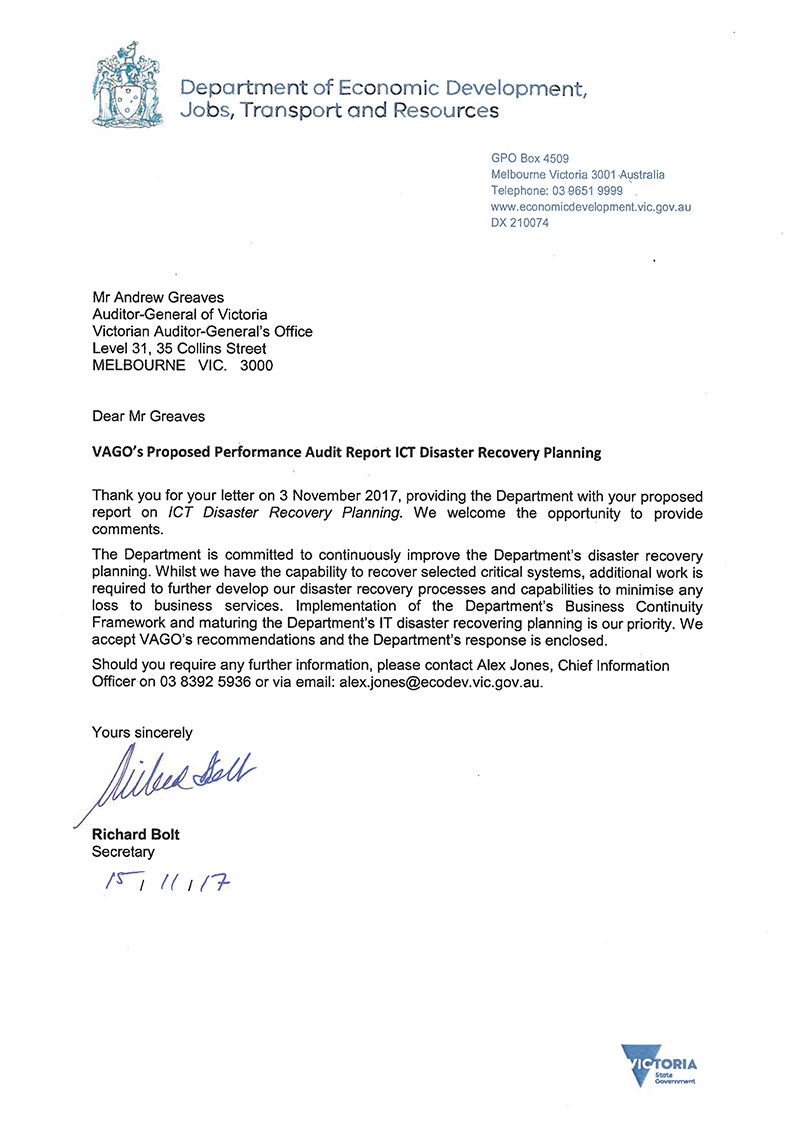
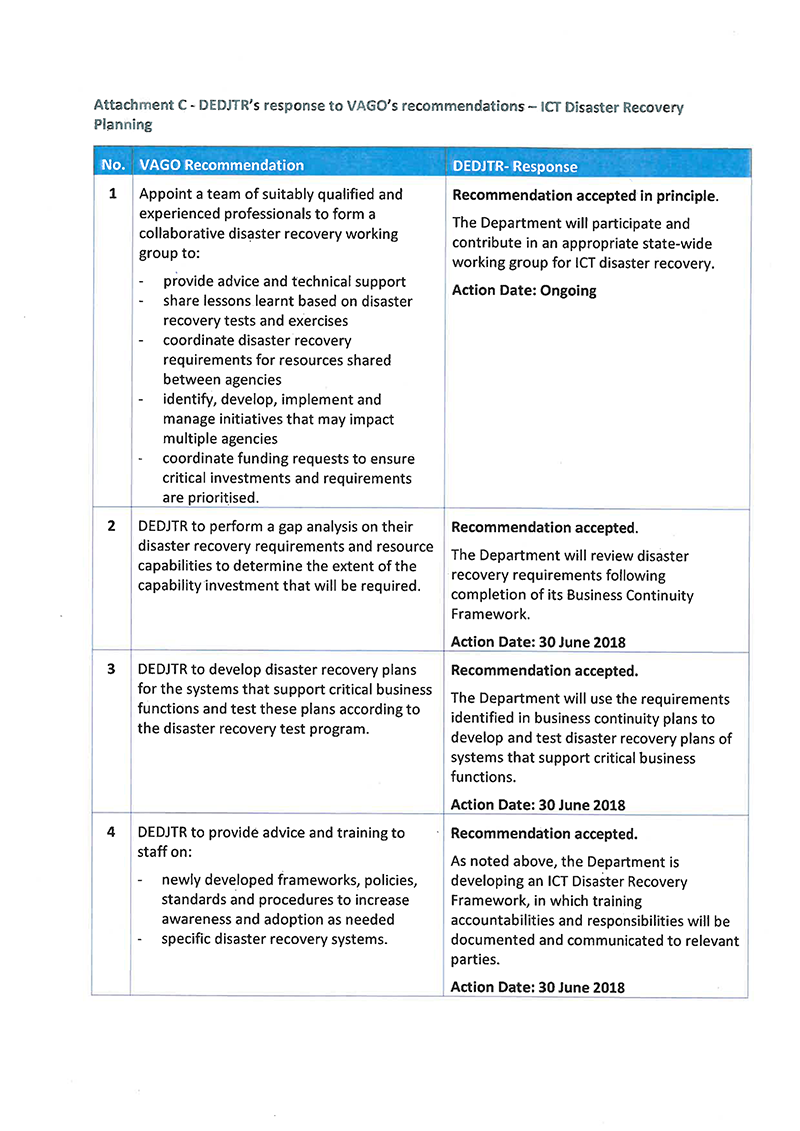
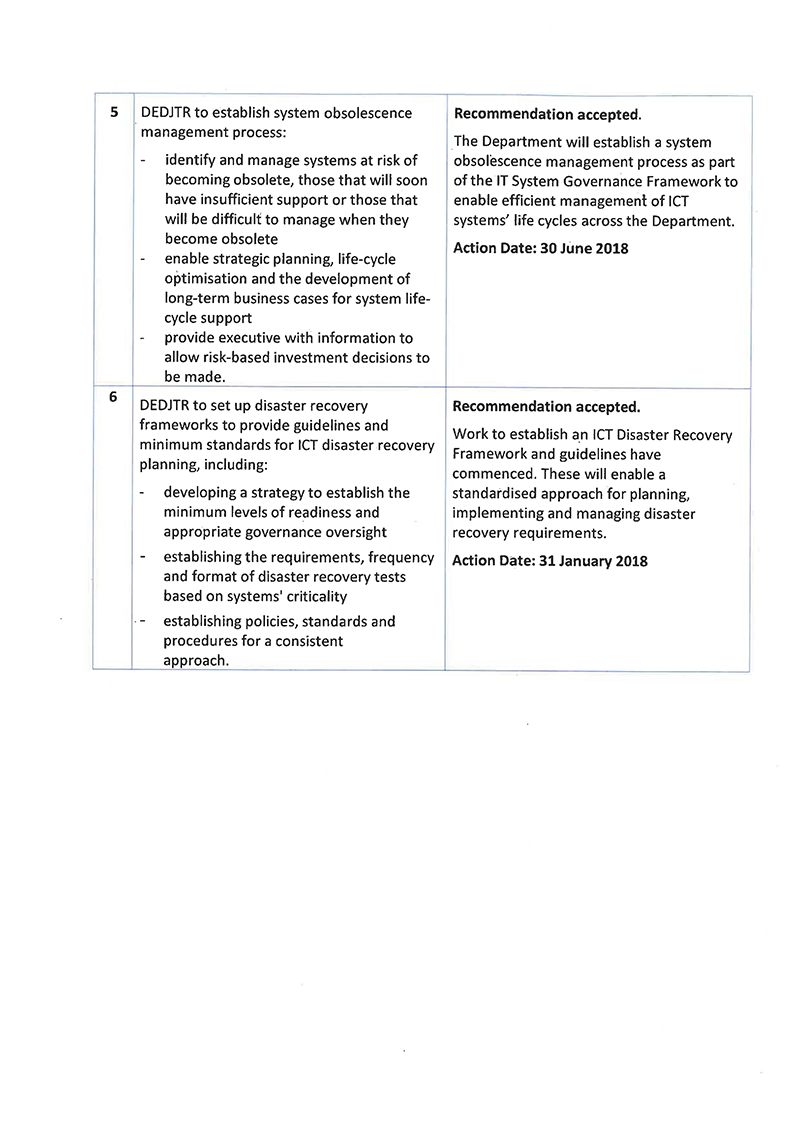
RESPONSE provided by the Secretary, DELWP

RESPONSE provided by the Secretary, DHHS
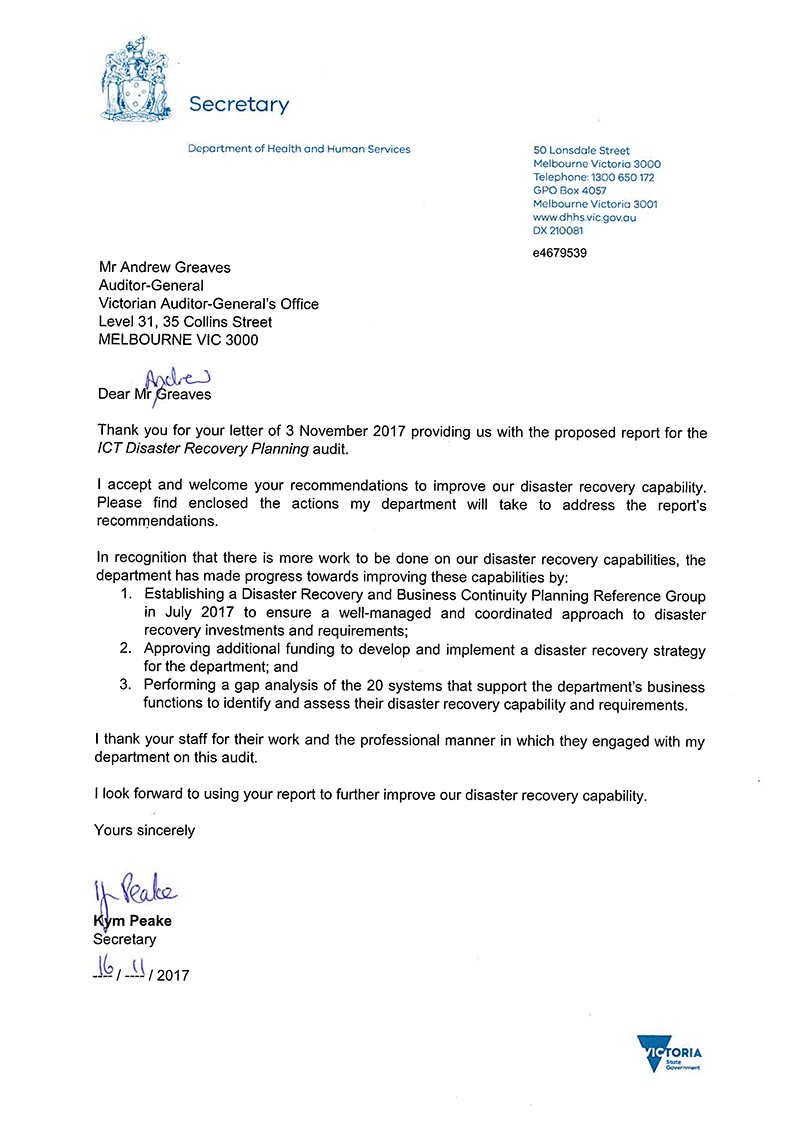
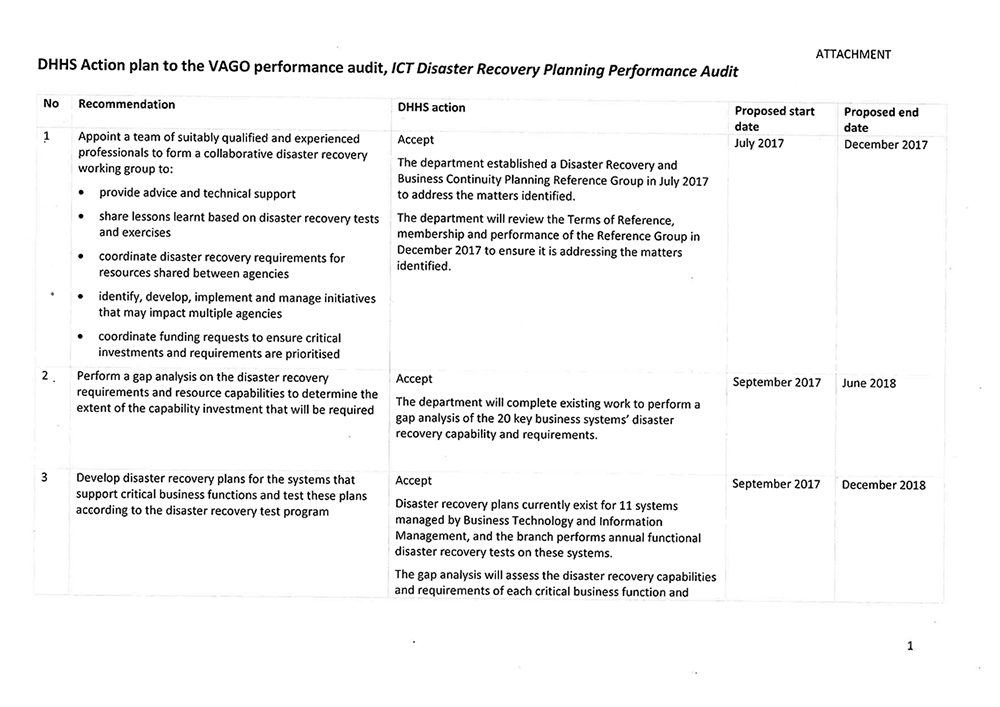
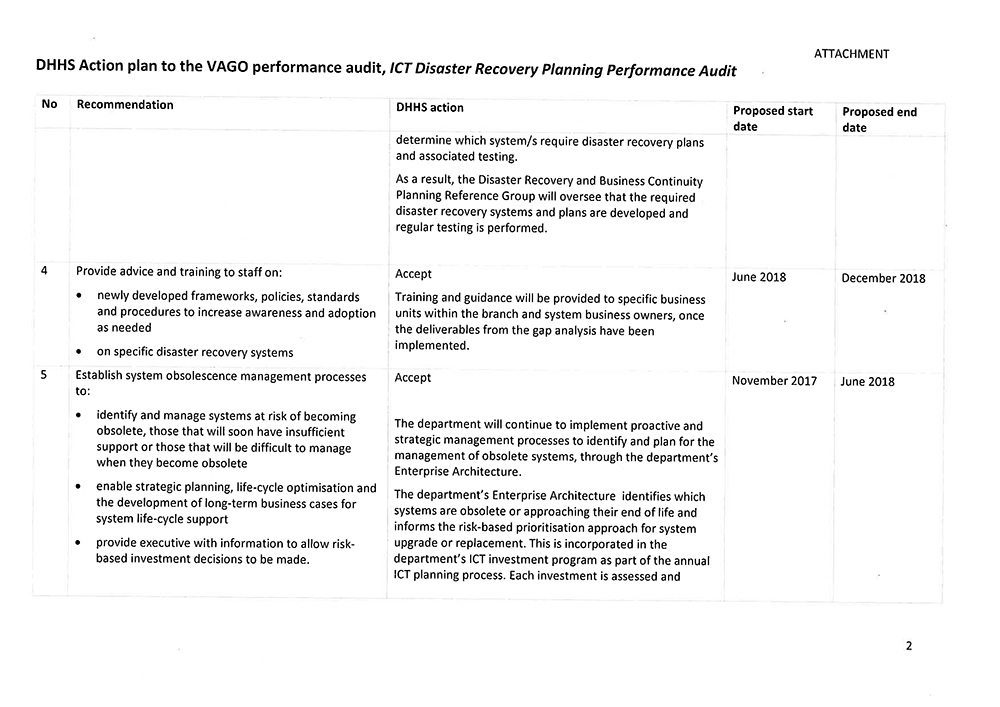
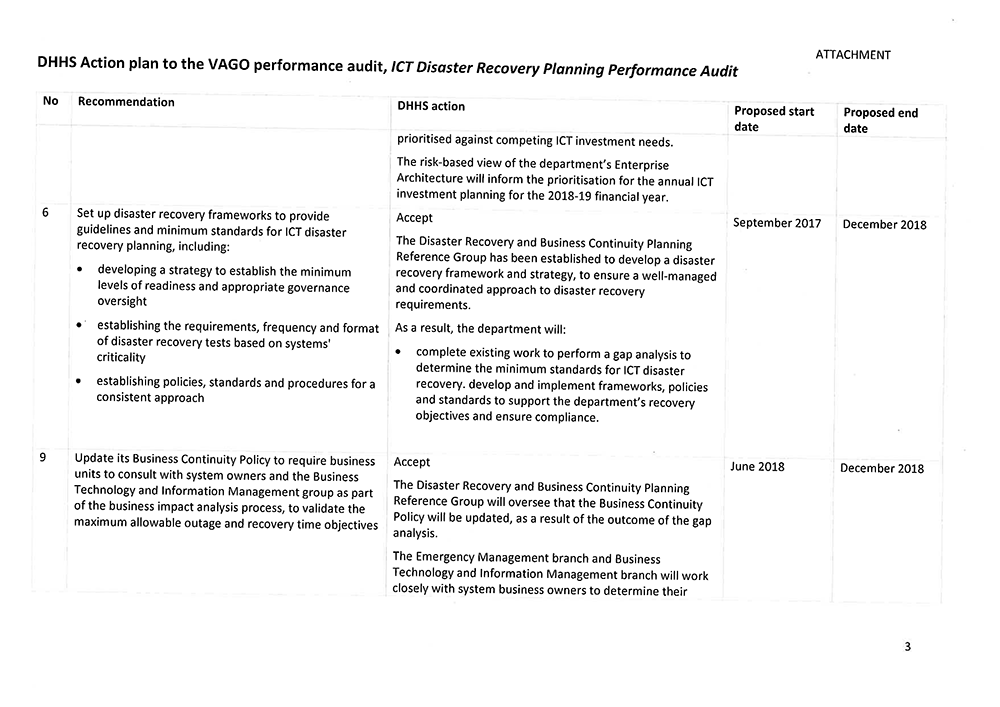
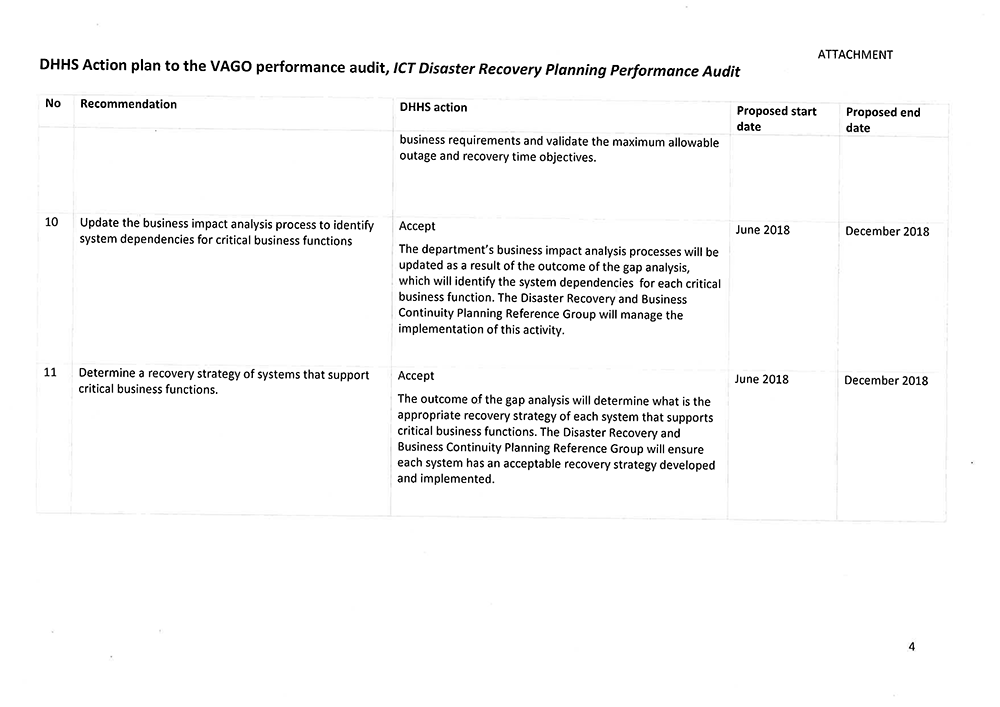
RESPONSE provided by the Secretary, DJR
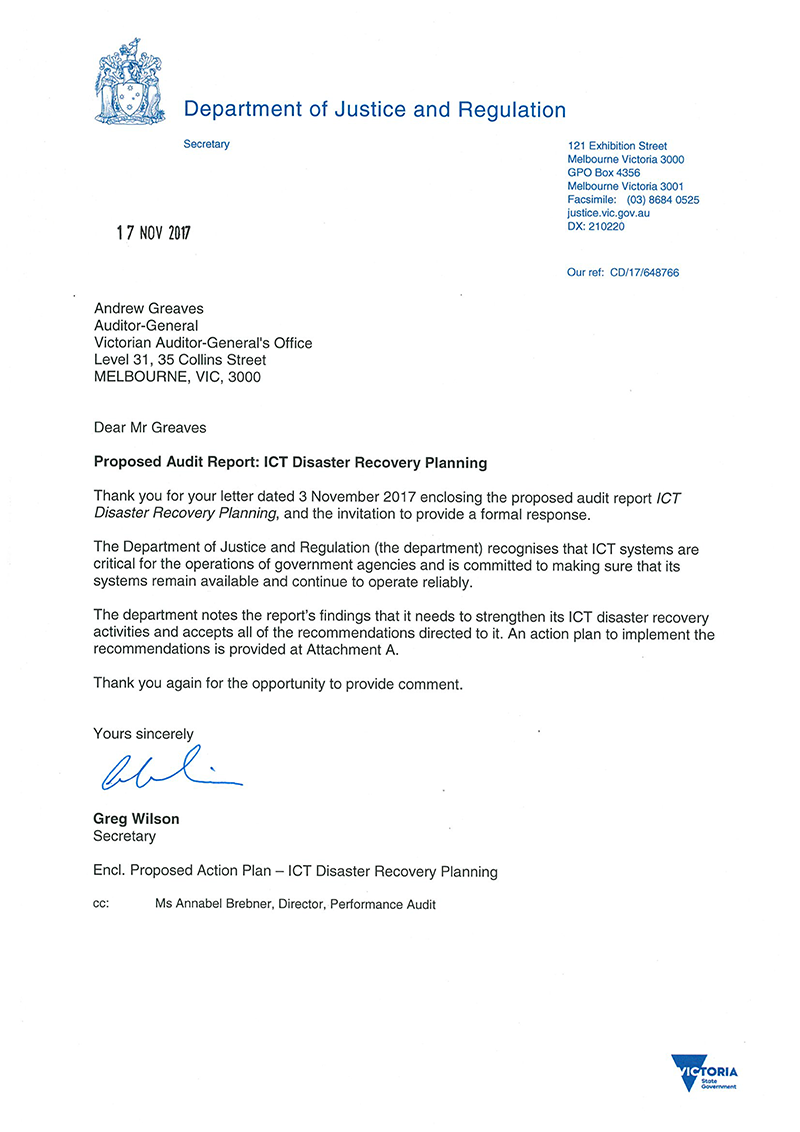
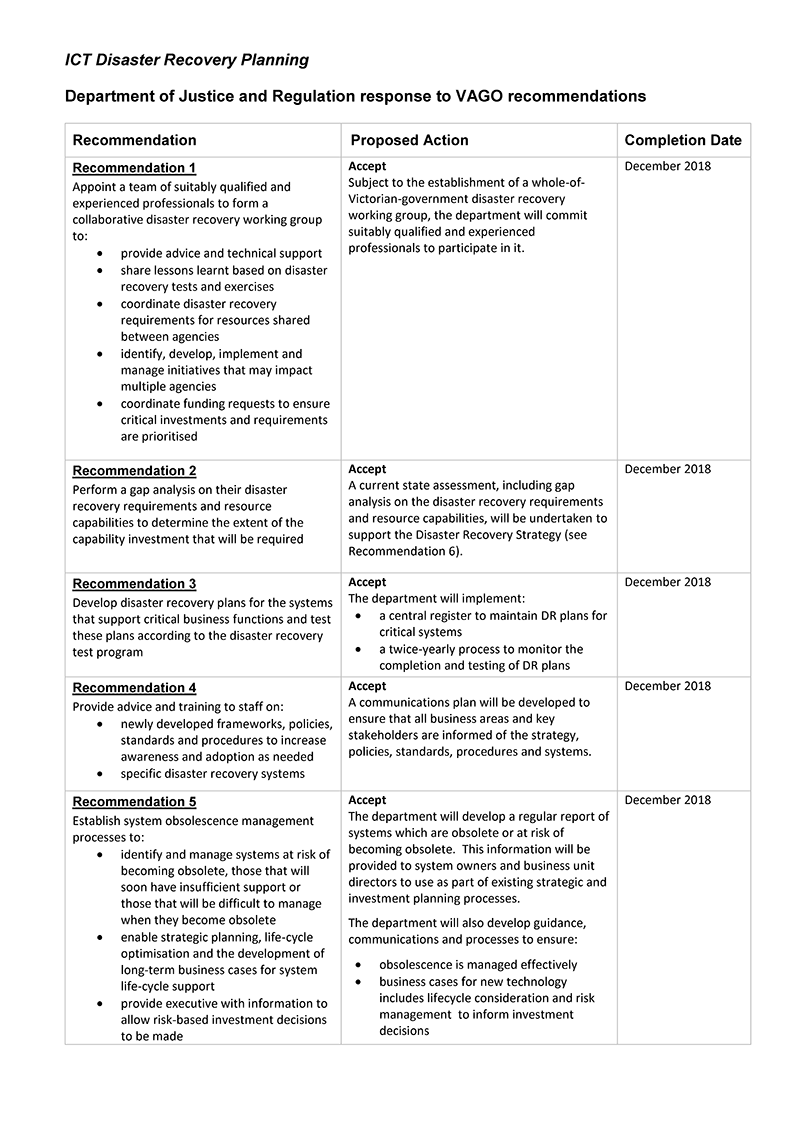
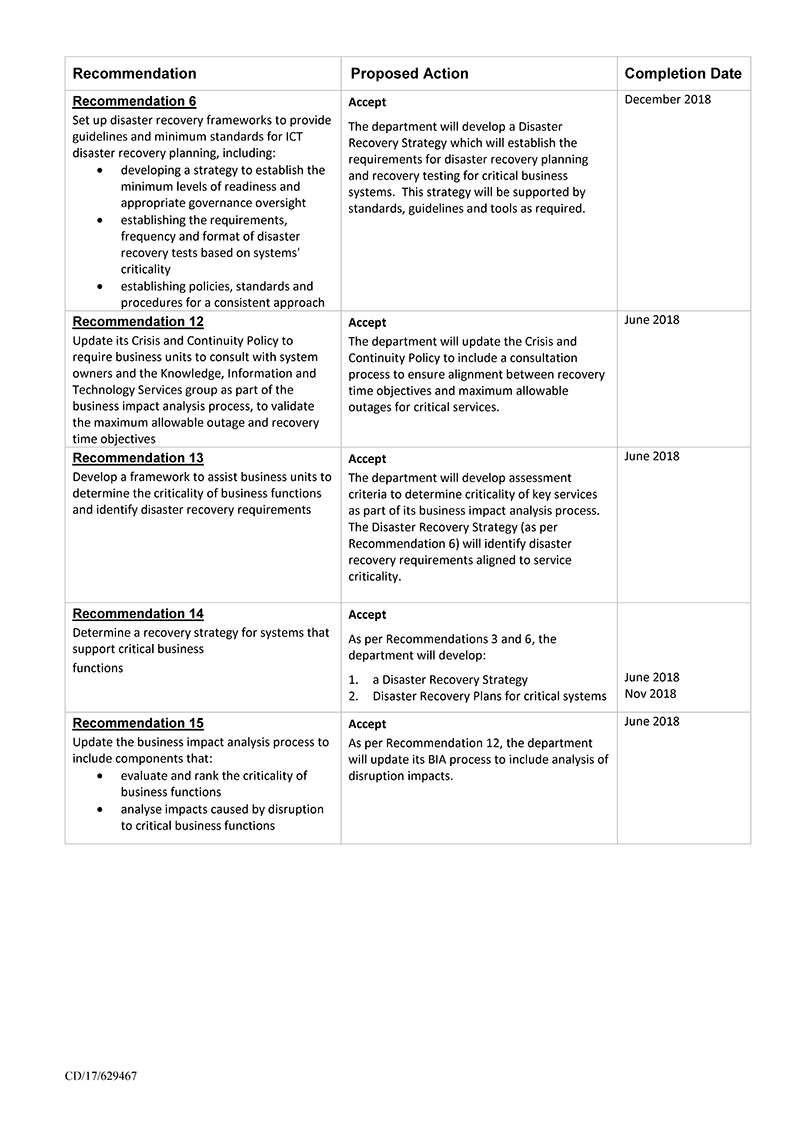
RESPONSE provided by the Acting Chief Commissioner, Victoria Police

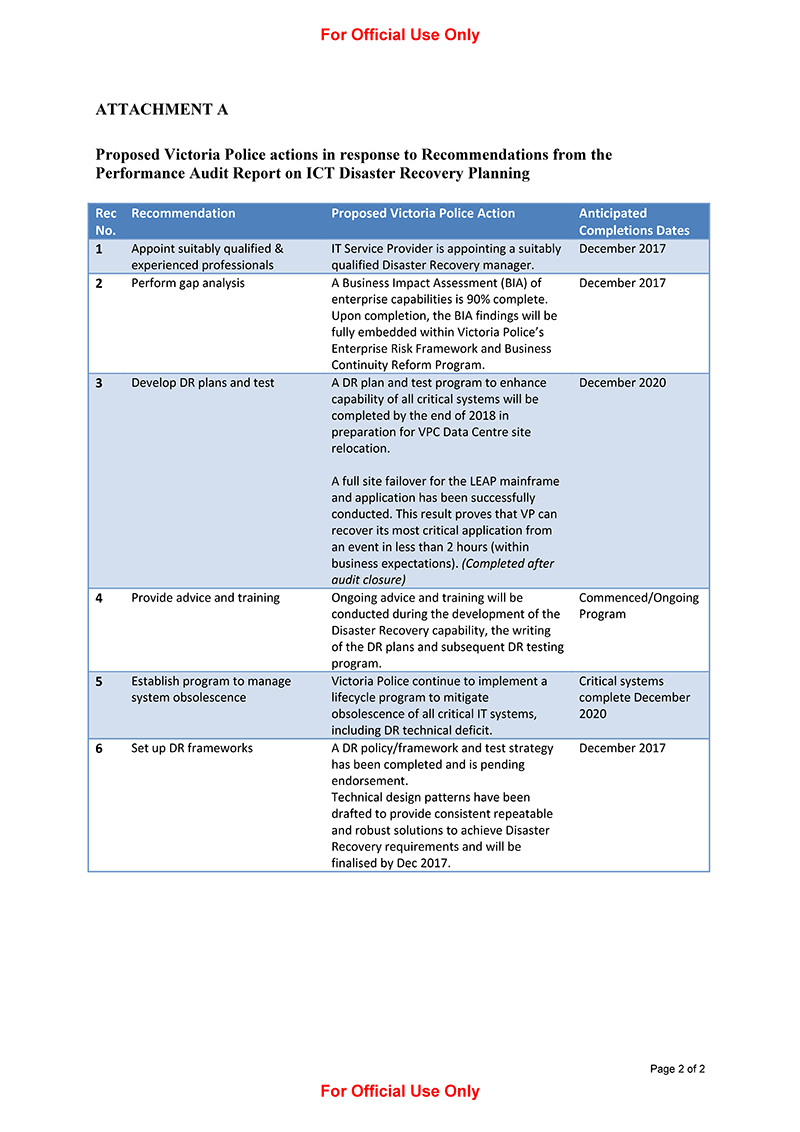
Appendix B. Capability levels and descriptions
Figure B1
Capability levels and descriptions based on COBIT 5 ISO/IEC 15504 capability levels
|
Capability level |
Description |
|
|---|---|---|
|
|
Incomplete |
Process not in place or it cannot achieve its objective |
|
|
Performed |
Process in place and achieves its purpose |
|
|
Managed |
Process implemented in a managed way and appropriately controlled and maintained |
|
|
Established |
Process implemented using a defined process that is capable of achieving its outcomes |
|
|
Predictable |
Process operates within defined limits to achieve its outcomes |
|
|
Optimised |
Process continuously improved to meet relevant current and projected enterprise goals |
Source: VAGO, based on COBIT 5 ISO/IEC 15504 capability levels.
Figure B2
Process components based on the ISO/IEC 15504-2:2003 standard
|
Rating |
Description |
Achievement (percentage) |
|---|---|---|
|
Not achieved |
Little or no evidence of achievement of the defined component of the process |
0–15% achievement |
|
Partially achieved |
Some evidence of an approach to and achievement of the defined component of the assessed process |
>15–50% achievement |
|
Largely achieved |
Evidence of a systematic approach and significant achievement of the process, with some opportunities for improvement remaining |
>50–85% achievement |
|
Fully achieved |
Evidence of a complete and systematic approach and full achievement of the component of the assessed process, with no significant remaining weaknesses |
>85% achievement |
Source: VAGO, based on ISO/IEC 15504-2:2003 standard.






